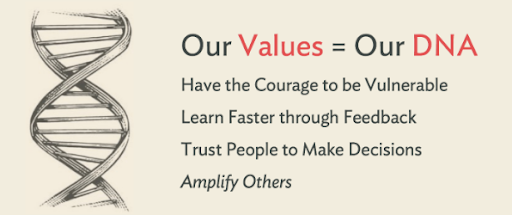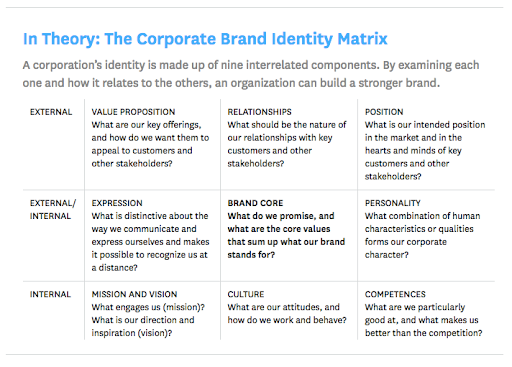Rebranding around mission and values
Rebranding around mission and values
- Defining mission and core values
- Consumers are increasingly voting with their wallets
- Which brand are you? Three strategies to rebrand around your mission and core values.
- Key takeaways
When Jim Collins and Jerry Porras published their book Built to Last in 1994, it spread through the business community like wildfire. The duo had studied the founding, growth, and development of a series of "visionary" companies that had stood the test of time — companies like Hewlett-Packard, Procter & Gamble, Sony, Disney, and Walmart — comparing each to a similar company that hadn't performed as well. Their findings were stark.
"In 17 of the 18 pairs of companies in our research, we found the visionary company was guided more by a core ideology — core values and a sense of purpose beyond just making money — than the comparison company was," writes Collins. "A deeply held core ideology gives a company both a strong sense of identity and a thread of continuity that holds the organization together in the face of change."
The visionary companies had existed for an average of 100 years and had performed 15 times better than the overall stock market — evidence enough to ignite a full-blown mission and core values craze that swept through the business world throughout the latter half of the '90s. Companies began rebranding in droves, but many leaders and boards found themselves asking, "Is rebranding around mission and values really going to benefit my business? Where's the ROI?"
Defining mission and core values
Words like mission statement, purpose, and vision are often thrown around interchangeably, and they're used to convey the same sentiment: that organizations have a core ideology or reason for being beyond simply making profits. We'll define and use the words "mission" and "core values" from here on out for the sake of consistency and clarity.
Mission — An organization's reason for being. A company's mission should be aspirational: it defines why the company does the work it does, rather than how it does it. According to Jim Collins, your mission should represent a "big hairy audacious goal." Here are a few examples:
- Patagonia: "We're in business to save our home planet."
- TED: "Spread ideas."
- IKEA: "To create a better everyday life for the many people."
Core Values — The boundaries within which the organization will operate in pursuit of its mission. Take for example Patagonia's core values:
- Build the best product
- Cause no unnecessary harm
- Use business to protect nature
- Not bound by convention
These values are designed to influence the company's behaviors and decision-making, while reinforcing their mission to "save our home planet." To "build the best product," Patagonia focuses on creating durable goods that will remain in use to limit environmental impact. They also use eco-friendly materials and manufacturing processes so that they "cause no unnecessary harm." In both cases, the core values drive behaviors in support of the company's overarching mission.
"Core values are the deeply ingrained principles that guide all of a company's actions; they serve as its cultural cornerstones," says Patrick Lencioni, CEO of The Table Group. "They are the source of a company's distinctiveness and must be maintained at all costs."
Values — much like brands — are ultimately all about trade-offs. "They limit an organization's strategic and operational freedom and constrain the behavior of its people," continues Lencioni. "If you're not willing to accept the pain real values incur, don't bother going to the trouble of formulating a values statement."
Next we'll look at new data that provides leaders and boards with the evidence that they are looking for: rebranding around mission and values delivers bottom-line business results.
Consumers are increasingly voting with their wallets
While Collins and Porras popularized the importance of mission and core values more than two decades ago, only recently have we seen these attributes begin to influence consumers' buying behaviors. According to a 2018 survey of over 30,000 consumers by Accenture, two-thirds of consumers around the world prefer to buy products from companies whose purpose "reflects their personal values and beliefs."
"Five years ago, trust in a company was really that they did what they said they would," said Rachel Barton, Managing Director at Accenture Strategy. "In the last few years it has moved to trusting the foundations and purpose on which a company is built."
Aligning your brand with your company's mission and values isn't just a nice idea; it's a brand strategy with tangible business benefits. "Having a brand that is consistent with your company's public values can garner consumer loyalty and make people feel good about the purchases they are making with your company," says George Ball in his article "The Importance Of Sticking To Your Company Values."
According to Lencioni, mission and values can even serve as an important point of differentiation. "Values can set a company apart from the competition by clarifying its identity," he says.
There have been many recent examples of consumers voting with their wallets, and the results go both ways: if a brand doesn't live its values, consumers will boycott its products, while brands that do live their values are seeing increased sales. Consider cosmetics company Sephora, whose core values include respect for all, expertise, and initiative. The company's customers recently called for the company to drop its partnership with Olivia Jade Giannulli when she was ousted as part of a cheating scandal where she paid to gain admission into the University of Southern California. As an ambassador of the brand, her actions were clearly not displaying "respect for all."
On the flip side, Patagonia showed that it wasn't afraid to speak out against mass consumerism when they famously took a stand against Black Friday in 2016. Rather than seeing Black Friday as an opportunity to line their pockets, the company instead acted with their mission in mind and decided to donate 100% of Black Friday sales to environmental organizations. The move resonated deeply with consumers: Patagonia had forecast sales of $2M-$4M for the day but ended up generating over $10M in sales.
With mission and values increasingly influencing consumer behavior, we'll next look at three specific scenarios that leaders may encounter as they consider strategically rebranding with mission and values top of mind.
Which brand are you? Three strategies to rebrand around your mission and core values.
There are a few common scenarios that present an opportunity for a company to rebrand around its mission and values; in this section, we'll explore three of the most common.
"When undertaking a rebrand, whether it's a logo update or total overhaul, the goal is to translate the brand's internal core identity into an external brand identity using every communication tool possible," says Josh Ritchie in his article "Why A Good Rebrand Starts With A Brand's Core," published in Forbes. "No matter how beautiful the logo or powerful the tagline, if a brand doesn't know its core — who or what it truly is — it is pretty much impossible to build their brand and a headache to even try."
Consider which of the following scenarios best describes your situation as you undertake your rebrand.
The brand that needs to rebrand to better align with its mission and values
Many brands first consider rebranding when they realize that they have a deeply held mission and set of core values that their existing brand doesn't reflect. The goal of the rebranding effort, then, is to realign the brand with the company's mission and values. This circumstance is rarer than you might think — if the company's mission and values were truly meaningful, they'd likely already be reflected in the brand.

One company that encountered this scenario is Vungle, a mobile advertising and app monetization platform. As an adtech company, data and performance have always been an important part of the company's identity — but so had creativity. The ethos of the company was summed up in the phrase "Powered by Creativity. Driven by Performance." Yet the company was competing in a market dominated by companies trying to convey a polished big-brand image; lot of blues and grays with very little human expression.
"We call this the 'sea of sameness,' where visual representations of a brand don't do justice to its true personality," says Vungle CEO, Rick Tallman. "At Vungle, we realized that people knew our name, but they didn't know who we really are. Our visual identity failed to capture our character."
The Vungle team set out to rebrand around the idea of "Powered by Creativity. Driven By Performance." Here's a look at some variations of Vungle's new, more dynamic logo after rebranding.

The right arm of the V in the logo is always solid, moving up and to the right, evocative of the results and performance Vungle's product drives for their customers' businesses. The left arm of the “V” and the color palette, however, connect the brand to its creative side. "The Vungle V has many colorful variations in the wild to represent the flexibility, creativity, and prevalence of our work," says Tallman.
Actions to take
If you find yourself in a similar situation, here are some specific questions to ask as you go through the rebranding process:
- Can the brand's mission be reflected through its logo, either obviously or abstractly?
- Do the images, illustrations, and photography the brand uses reflect its core values?
- Does the color palette elicit certain emotions?
- If the brand were a person, who would it be?
- Does the brand's tone and voice align with its values?
- Are there words the brand should avoid in its messaging?
- How does the brand's heritage story reflect its mission and values?
The brand that pays lip service to its mission and values but doesn't live them
A second (and perhaps the most common) set of circumstances is the brand that has an existing mission and set of core values that's simply not meaningful. This most often occurs in companies where mission and values are viewed as an "activity" to be handled once during a leadership off-site and then they are forgotten altogether. Defining your company's mission and values once is not enough and will be harmful to your brand unless you practice what you preach. Consider the following core values:
- Communication
- Respect
- Integrity
- Excellence
They sound great, right? But they're the meaningless core values of Enron, a company that became the poster child for corporate fraud and corruption in the early 2000s. "Most values are bland, toothless, or just plain dishonest," says Lencioni. "And far from being harmless, as some executives assume, they're often highly destructive. Empty values statements create cynical and dispirited employees, alienate customers, and undermine managerial credibility."
If your brand is guilty of not living your values, your rebranding efforts need to focus on creating a brand that actively lives your stated values. How do you do that? Take Trader Joe's: their values include "Wow customer service" and "The store is the brand." Beyond the company's logo and typeface, the design of their physical store locations presents a massive opportunity for Trader Joe's to live their stated values.
When you first enter one of their store locations, you'll be greeted by flowers. You'll proceed to walk up and down extra-wide aisles, staff will offer you free samples of Trader Joe's products and offer recipe tips, and cashiers will ask you about your day and chat with you about your grocery selections. "Have you tried this sweet potato gnocchi? It's great with our Backbone cabernet," may seem out of place at other grocery stores, but it's the norm at Trader Joe's.
"Trader Joe's is quirky, original, delightful and designed to create an overwhelmingly positive customer experience, starting with the flowers at the entrance," says Cathy Hotka, Principal at Cathy Hotka & Associates.
Wistia, a video hosting software platform, is an example of a brand who strayed from core values that they then needed to rediscover. The company's values include "long-term thinking" and "creativity," two values that drove the company's decision-making in the early days.
"One of the first big investments we made was in content marketing," says CEO Chris Savage. "We knew that businesses struggled with where to start when it came to making video, so we thought it would be helpful to teach them all of our video-making secrets. And even though it cost us hundreds of thousands of dollars to produce this content, we gave it away for free. We trusted that if the content was free, more people would see it and make videos of their own. Which meant in the long-term, more people would become Wistia customers."
Wistia's decision to share their creative secrets and invest in content marketing was a long-term play very much in-line with their values, but after raising money from investors, the company began to prioritize projects designed to show a more immediate return on investment to their investors.
"You'd think that pouring money into our business and running at a loss meant we were taking more [creative] risks, but we weren't," says Savage. "Instead of the creative long-term risks (in-line with our values) we relished in taking, we were taking financially-motivated risks in service of accelerated growth."
In order to prove that the values on their walls were meaningful — both to their employees and their customers — action was needed. Savage and his co-founder decided to take on $17M in debt to buy out their investors, freeing them from the need to deliver short-term revenue growth in line with investor expectations. They quickly got back to taking the long-term creative risks they so relished; the company's One, Ten, One Hundred video series is just one example.
Actions to take
If your brand is paying lip service to values that it's not living, the rebrand that you need to undertake does not necessarily include a new logo, typeface, or voice and tone. Instead, your rebrand should be driven by your actions.
- Reassess your existing mission and values — Start by taking a close look at your brand's existing mission and core values, the ones you've been paying lip service to. Are they the right ones and you're just not living them, or do you need to start from scratch? If you need to start from scratch, follow the steps outlined in the next section.
- Brainstorm all of the ways your brand can live your values — Assuming that you find that your mission and values are still relevant, you should start by identifying all of the possible ways your brand can possibly live those values. For example, Wistia didn't want to take on $17.3M in debt, but they knew that as long as they had to answer to investors, they wouldn't be free to take the long-term, creative risks that were in line with their values. As such, it was an action they needed to take. Start by going through each of your values one-by-one, and create an exhaustive list of actions you can take that would bring each value to life.
- Prioritize and take action — Once you've created a list of ways your brand can live its values, you should prioritize the ones that feel most aligned with your mission and values. Don't be afraid to be bold — it typically takes making a splash to change consumer perceptions of your brand. In this case, your "rebrand" is not merely a matter of changing your logo, typeface, or tagline; it's about taking actions dramatic enough that consumers take note and making sure that those actions are directly aligned with your mission and values.
The brand that needs to discover its identity
A third circumstance occurs when a brand either hasn't identified its mission and core values or realizes that their existing mission and values aren't the right ones. In this case, the rebranding process needs to begin by pinpointing the brand's identity.
For agencies that are hired to help with the rebranding process, there are often tell-tale signs of this scenario once they start working with a new client. For example, "their feedback is conflicting or they can't clearly answer simple questions," says Josh Ritchie, CEO of Column Five. "You end up stuck in rounds of fruitless iteration, and everyone ends up frustrated. If this sounds all too familiar, you're probably running into the most common problem in branding: The brand doesn't know who or what it is."
Culture Amp, a company whose product helps employers collect and act on feedback from their employees, found themselves needing to discover their mission and values for the first time in late 2014. Company founders, Didier Elzinga, Doug English, Rod Hamilton, and Jon Williams, started by assembling in the office late one night and jotting down ideas that they, as individuals, thought were foundational to the mindset of the company.
Each member of the group drafted statements that started with "We are/believe/strive for" and then shared their responses with the other group members. Here are some examples of the statements they drafted:
- "If there was an overriding theme it was we believe in the power of feedback... turned into continuous improvement." – Jon
- "We are courageous - we take risks, but they are 'smart' risks backed by some data." – Rod
- "I believe in trusting people to make decisions. Not by consensus but by transparency. We decide who the right person is to make a decision, we give them as much input as we can and then we let them make the decision - and most importantly be accountable for the consequences of that decision. Consult widely but make decisions and live with them." – Didier
- "We are there to help our customers solve real problems - i.e., we're not just administering a survey, we're helping them create their ideal culture" – Rod
- "I believe in courage. The courage to challenge the way things are done and the assumptions people make (i.e., how to build a sales team, how to position a brand, etc.) and also the courage required to be emotionally vulnerable at work." – Didier
After sharing their statements with one another, the group identified common themes and questioned each other's outputs until they arrived on a set of core values for the company.

Next we'll explore two different strategies you can use to help a brand discover its identity.
Actions to take
Ideally, assembling a company's mission and values should occur early on — and in most cases, the mission and values will be highly reflective of the personal values of the company's founders. If that hasn't happened, there's no better time to start the process than now.
First, begin by recognizing that your values don't need to be universally accepted. They should reflect what matters to your company first, because it's the people inside the building that will be expected to make decisions based on these values. But you need to make sure that the values you decide on are also important to some segment of potential buyers.
Second, you'll want to aim for values that are actionable and distinct. "55% of all Fortune 100 companies claim integrity is a core value, 49% espouse customer satisfaction, and 40% tout team-work. While these are inarguably good qualities, such terms hardly provide a distinct blueprint for employee behavior," says Lencioni. "Cookie-cutter values don't set a company apart from competitors; they make it fade into the crowd."
Defining mission and values as a small company
If you're working with a small company, follow this process to identify your mission and core values.
- Poll your team individually — To start, provide handouts to everyone on your team, and give them space to think as individuals. Consider asking them questions like:
- What do you value as a person?
- What unspoken values have contributed to our success to date?
- What's a big, hairy, audacious goal you'd like to see our company achieve?
- What motivates you to come to work every day?
- What do successful employees here have in common?
- What values should govern the way we act with each other and our customers?
- Put all of the ideas on a whiteboard — Next, put all of the ideas that your team came up with as individuals onto a whiteboard. It's best to have everyone jotting ideas onto the board at the same time to limit the extent to which they are influenced by one another's ideas.
- Create a shortlist — Next, ask everyone to select and rank a shortlist of the top 10 values they see on the whiteboard. Compare shortlists as a group, with the most common responses becoming a set of contenders.
- Sleep on it — This process can be messy and elicit some passionate responses from your team; that's a good thing and an indication that you've landed on some meaningful values. Take a break from this initial activity, and revisit your list after some time has passed. When you come back to your list, the time you've given yourself to ruminate will have helped surface the mission and values for your company.
While this approach is simple and tends to work well for small organizations, it can be problematic in larger organizations. "Surveying all employees about what values they believe the company should adopt is a bad idea for two reasons," says Lencioni. "First, it integrates suggestions from many employees who probably don't belong at the company in the first place. And second, it creates the false impression that all input is equally valuable."
Defining mission and values in larger organizations
Stephen Greyser and Mats Urde provide a more comprehensive framework for this process in their article "What Does Your Corporate Brand Stand For?" published in Harvard Business Review. The authors created a tool that they call the Corporate Brand Identity Matrix.

The matrix identifies nine interrelated components. Leadership teams are encouraged to work together to answer the nine questions identified within the matrix in short, declarative sentences. Your team should then gauge how clearly their responses align along the matrix's diagonal, vertical, and horizontal axes, which all pass through the "brand core" at the center.
Each axis corresponds to a different kind of organizational capability. The diagonal one that begins in the bottom-left corner highlights capabilities related to strategy; the diagonal one that begins in the top-left corner, competition; the horizontal one, communications; and the vertical one, interaction. If your corporate brand identity is clear, the elements on each axis will harmonize — each of the elements will inform and echo the brand core, resonating with the company's values and what the brand stands for. The brand core, in turn, will shape the other eight elements.
Only once a brand has discovered its mission and values can it rebrand with these elements in mind — for both agencies and brand managers, this presents a very real opportunity to rebrand in a way that's more meaningful to the brand's customers.
Key takeaways
- Consumers are increasingly willing to pay more for products or services made by companies that share their personal beliefs and values.
- Rebranding affords companies with a valuable opportunity to make sure their brand is reflective of their mission and core values.
- Brands must be willing to make sacrifices in service of their values. Your mission and values are worthless unless they permeate every aspect of your brand experience and drive your actions as a company.